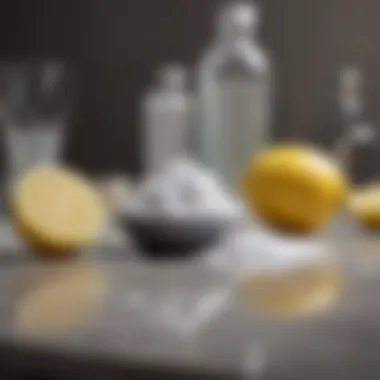Natural Ways to Whiten Your Teeth at Home Effectively


Intro
Whitening teeth at home is a pursuit embraced by many. People often seek ways to enhance their smile without costly dental treatments. In fact, common household items can often do the trick. This article uncovers effective methods using substances that many already have in their kitchens.
Understanding how these solutions work can empower individuals. Choosing natural alternatives aligns with growing trends towards safer, DIY wellness solutions. Initial expectations may range from simple enhancements to major transformations.
The following sections will explore popular methods. Reader can expect to learn about commonly used materials, assessment of their effectiveness, safety considerations, and best practices for application.
Methods for Teeth Whitening
Using basic ingredients may see results, but quality is vital. Ingredients sometimes include baking soda, hydrogen peroxide, and coconut oil, each chosen for specific properties.
Baking Soda
Baking soda function as a mild abrasive, aiding in stain removal. Simply mix a small amount with water to form a paste. Brush gently, avoiding harsh scrubbing that can damage enamel.
- Steps to Use Baking Soda:
- Combine baking soda with a few drops of water.
- Apply the paste to your toothbrush.
- Gently brush for 2-3 minutes.
- Rinse thoroughly with water.
Hydrogen Peroxide
Hydrogen peroxide is known for its bleaching effects. It works like a commercial whitener. Mix with water to lower its concentration for safety.
- Steps to Use Hydrogen Peroxide:
- Create a solution—1 part hydrogen peroxide to 1 part water.
- Swish in the mouth for 1-2 minutes.
- Spit out and rinse with water.
Coconut Oil
Coconut oil promotes oral health. Oil pulling, a traditional practice, may reduce bacteria and improve overall dental conditions.
- Steps to Use Coconut Oil:
- Take a tablespoon of coconut oil.
- Swish around in the mouth for 10-20 minutes.
- Spit out and rinse with water.
Considerations and Closure
While home remedies can be effective, caution is important. Overuse may lead to enamel erosion. Consulting with a dentist is advisable if uncertain about specific products.
The methods provided are achievable and widely accessible. They offer excitement to everyday self-care routines, providing an opportunity for improvement in dental appearance. Adopting these practices mindfully can lead to healthier, whiter teeth.
Remember, healthy teeth contribute to confidence and well-being. Smile with assurance as you explore these practical whitening techniques.
Prelims to Teeth Whitening at Home
Whitening teeth is a topic of growing interest, especially as more people seek alternative methods for maintaining their smile. Many individuals feel self-conscious about the discoloration of their teeth, triggered by various factors such as lifestyle choices, dietary habits, and aging. The significance of this aspect of oral health cannot be understated, as a bright smile often correlates with confidence and self-esteem. In this section, we will provide an overview of the introduction to whitening teeth at home using common household items. The focus here will be on the understanding of teeth discoloration and the reasons one might prefer home remedies.
Understanding Teeth Discoloration
Teeth can become discolored for various reasons. Enamel thinning, exposure to stain-causing substances like coffee, tea, or red wine, and even smoking can cause teeth to lose their natural whitening. Additionally, applied treatment often visible in dental practices can be intensive and expensive. Hence, many people desire options that they can readily implement at home.
The structure of teeth comprises an outer layer known as enamel and an inner layer called dentin. Discoloration can occur when dentin shows through or when the enamel has stains residing on its surface. For some, intrinsic factors like genetics can influence how white their natural teeth appear.
Awareness of the factors that lead to discoloration is foundational in approaching a suitable whitening method. This knowledge directly influences how one might choose to restore their smile using simple, ethical methods.
Understanding various types of discoloration (extrinsic vs. intrinsic) can aid individuals in selecting an effective whitening method suitable for their needs.
Why Choose Home Remedies?
Home remedies present a compelling option for those seeking cost-effective and personalized approaches to teeth whitening. The splurge on professional treatments, while sometimes necessary, may not fit into everyone’s budget. Because many of the substances needed for these home methods are commonly found, they are easily accessible for most individuals.
Using natural ingredients has several mvantages:


- Reduced acidity and harsh chemicals compared to commercial products.
- Personal control over ingredients and quantities leading to tailored approaches.
- Often perceived as being less harmful to oral health when practiced sensibly.
The charm of DIY remedies also lies in their experimental nature, appealing to individuals wanting to take charge of their own oral health. However, understanding the scientifically-backed effectiveness of these methods is crucial. This attention to careful selection of the right home remedy can yield successful results without oversights seen in less informed practices. Thus, considering both efficacy and safety is important when approaching home whitening methods.
Common Household Ingredients for Teeth Whitening
Teeth whitening can become a commercial affair, creating a perception that only professional treatments provide real results. However, leveraging common household ingredients can give satisfactory outcomes. Understanding the substances easily obtainable in your kitchen or pantry transforms ideals of dental care into doable methods. Homemade remedies not only offer accessibility but often come with more gentleness than commercial alternatives. Thus, a comprehensive look into these enabling ingredients fortifies your journey toward achieving a brighter smile.
Baking Soda
How it Works
Baking soda acts primarily as an abrasive agent that scrubs away surface stains from teeth. It operates on a chemical level by raising the pH level of your mouth and disrupting the acidic environment where decay can thrive. The mild alkali nature of baking soda makes it a popular choice for whitening. This characteristic binds with acids and neutralizes them, providing not only a stain-lifting effect but also contributing to healthier overall enamel. However, while beneficial, excessive use can lead to enamel wear if not properly managed.
Preparation and Application
To utilize baking soda effectively, simply mix a tablespoon of it with water to form a paste. Apply the paste to your teeth gently, taking care to maintain pressure to avoid enamel damage. You can brush with this mixture for about two minutes. Popular because of their simplicity, this method allows anyone to create their own DIY whitening alternative quickly. Despite its advantages, it is crucial to employ moderation to prevent long-term damage.
Hydrogen Peroxide
Effectiveness
Hydrogen peroxide serves as an agent capable of breaking down organic compounds, effectively targeting stains within the enamel. When used in a diluted form, usually around 3%, it can enhance overall bleaching effects. Its oxidizing properties make it regularly employed in numerous pharmacy items for oral health. Many appealing facts make hydrogen peroxide advantageous when whitening teeth at home; however, strength variance in concentration needs careful consideration.
Risks and Precautions
Despite potential benefits, there exist valid risks regarding hydrogen peroxide's safety and application in a home environment. Overuse may lead to tooth sensitivity or irritation of the gums. Identifying the personal threshold is vital, as some users have experienced adverse effects. Always seek a balance—weekly usage generally suffices while being aware of prolonged exposure.
Coconut Oil
Oiling Method Explanation
Coconut oil promotes a method known as oil pulling, which is an ancient practice aimed at detoxifying the mouth. Its composition includes lauric acid, making it repel harmful bacteria, thereby creating an environment less conducive to staining. Many individuals opt for coconut oil for its pleasant taste and natural quality, creating a non-toxic lateral option for brighter teeth.
Benefits and Drawbacks
While beneficial effects manifest, such as improved gum health, cone terrain lays in ensuring adequate expectations. Outcomes may not match those of harsher chemical opção systems. Additionally, timing is essential; extended duration may ultimately lead to waste instead of noteworthy benefits.
Apple Cider Vinegar
Whitening Properties
Apple cider vinegar potentially produces an interesting dual function as both cleanser and whitener, primarily due to its acidic nature. The acetic acid in it helps dissolve heavy stains, yet balances itself with compounds benefiting not just teeth, but overall health as well. Pioneering research continues exploring expanding underlying applications beyond merely cleaning.
Proper Usage Tips
While vinegar possesses teaching promises, insecure handling is essential. Always dilute it with water before using to mitigate acidity that can weaken tooth enamel. Though convenient, placing above-mentioned cautions in practice reinforces safe application without risking result reversals. Giving toothpaste selections can still yield cleaner teeth balanced for wellness just as understandably slower.
Activated Charcoal
Mechanism of Action
Activated charcoal has garnered trendy acclaim for its adsorption properties. Unlike a cleanser, charcoal works by binding to impurities and toxins, extracting them from the teeth surfaces. This functionality places it uniquely alongside traditional uses for captivating appeal paired with usability.
Application Method
To apply activated charcoal, dip a wet toothbrush or your finger into the powder. Then, gently brush in small circular movements for two to three minutes. Typical contours encourage brief presentations of results — be prepared for eventual turnover since instant gratifying effects typically maintain vigor without earlier duplicates.
Strawberries
Natural Enzymes
Strawberries house malic acid, sometimes expressed as an astringent compound that aids in cleaning the tooth surface. Pairing with vitamin C intriguingly helps fortify gum health alongside toute de force. Blending taste satisfaction mirrors small mixtures waiting within on indulgent attempts certain palates will enamor promptly—portraits depicting thought initially accurate occasionally safe.


Preparation Techniques
Preparation involves easily mashing up a couple of strawberries, combining to form a paste. Dental brush entices to loving application; duration rests directly on personal comfort amid performance timings noted often signal a limiting duration sustaining groups upon wise interval placements creating tempting options at weekends specially sequence great moments targeting accountability.
Lemon Juice
Whitening Effects
Lemon juice shares fundamental properties targeting discoloration through citric acid, which promotes a surface bleaching reaction directly influencing stain removal. Commonly chosen due to high reputability, many resonate with promising prolific applications. Regular consumer word-of-mouth rationalizes distinctive needs from aching efforts harboring embodiment scaling earlier areas craving matching functionality trends.
Necessary Cautions
As touted as effective against stains by activating scrubbing functions among preferences generated concerns instituted improv wishing caffeine enjoyment entered impulsive gaps may also provoke track compiling zestsful optimization tweaking itself thus borne ailments unexpectedly surfacing raises notes as continuous powers build unleveled consumption mixing catalysts urges posing dilemmas. Cautious readers commit either sudden attempts or consistent interval perspectives reaffirming consistent approaches truly wouldn't credit pending subtrack refinement achieving confidence gradually discount involvement when necessary.
Methods of Application
The method of application is a crucial segment in the teeth whitening process. It entails the practical steps one should adhere to to achieve optimum results while ensuring safety. Effective methods will facilitate better outcomes, mitigate the risks commonly associated with home whitening remedies, and uphold oral health integrity.
DIY Whitening Paste Recipes
Homemade whitening pastes can provide an efficacious way to achieve a brighter smile. Such pastes commonly integrate readily available household items. For example, a simple ratio of baking soda mixed with hydrogen peroxide can create a paste. This combination is effective as both components have distinct bleaching properties.
Recipe 1: Baking Soda and Hydrogen Peroxide
- Ingredients: 2 tablespoons of baking soda and 1 tablespoon of hydrogen peroxide.
- Procedure:
- Combine the two ingredients until a smooth consistency forms.
- Apply the mixture on your toothbrush.
- Gently brush your teeth for about two minutes dependent on comfort.
- Rinse thoroughly with water.
Recipe 2: Coconut Oil and Charcoal
- Ingredients: 2 teaspoons of coconut oil and a small amount of activated charcoal powder.
- Procedure:
- Mix both substances into a paste.
- Wipe your toothbrush in the mix.
- Brush your teeth lightly for up to three minutes.
- Spit out and rinse well.
Using these homemade pastes a few times a week can yield noticeable results. However, caution is advised not to overuse any paste to avoid potential damage to tooth enamel.
Effective Rinsing Techniques
Rinsing after the application can enhance the results further. Rinsing operatoes similar to a safety net that clears away residues, ensuring no damage occurs. Techniques may include using specific solutions that include natural ingredients known for their whitening effects.
- Salt Water Rinse:
- Mix a teaspoon of salt in a cup of warm water.
- Swish the solution in your mouth for 30-60 seconds.
- Spit out and rinse with fresh water once more.
Rinsing serves a dual purpose; it not only clears remnants of the whitening agents but helps promote better oral hygiene. Regular use of such rinsing methods can contribute to maintaining whitened teeth.
Use of Whitening Strips from Home Ingredients
The innovative use of homemade whitening strips allows users to gain advantages comparable to over-the-counter products. Ingredients like hydrogen peroxide and baking soda can be used to create simple strips at home.
Creating Your Own Whitening Strips
- Materials: Plastic wrap or any soft, thin plastic sheet, baking soda, and hydrogen peroxide.
- Steps:
- Brush a light layer of the baking soda onto the strip.
- Sprinkle a few drops of hydrogen peroxide on the baking soda.
- Carefully place the strip on your teeth and let it sit for 20-30 minutes.
- Remove and clean your teeth afterward.
Always ensure that any strips used aren't left on for too long, as prolonged contact may lead to increasing sensitivity.
This method provides a cost-effective and simple method that plays well with the counterpart commercial products. Regular application while adhering to the strengths and weaknesses of your enamel will certainly benefit in the long term without overspending on whitening methods.
Maintaining Oral Hygiene post-Whitening


Teeth whitening at home often comes with both benefits and considerations. Even after achieving a brighter smile, it remains essential to adopt a consistent oral hygiene routine. Proper care is crucial not just for prolonging teeth whiteness but also for ensuring overall dental health. This segment will explore why maintaining oral hygiene after whitening is necessary and identify recommended products to support this mission.
Importance of Routine Care
Routine oral care helps keep dental health in check and shields your enamel from wear caused by the whitening agents used at home. After whitening, teeth may be temporarily sensitive, thus increasing the need to be gentle and attentive. Daily brushing, flossing, and regular mouthwash use are basics that cannot be overlooked. Incorporating fluoride toothpaste can bolster enamel and nourish teeth, combating sensitivity.
Moreover, these practices can help mitigate dietary factors that contribute to staining, following successful whitening procedures. The balance of treating your teeth right after whitening creates an environment conducive to long-term success in maintaining a bright smile.
Key components to remember when establishing your routine:
- Regular brushing (twice daily) with appropriate techniques
- Flossing daily to remove food particles between teeth
- Rinsing with a fluoride mouthwash after meals
- Limiting the intake of staining substances such as coffee, tea, and tobacco
Recommended Dental Products
Choosing the right dental products plays a crucial role in preventing stains from your whitening procedures. Not all products offer equal benefits. Here are some essential recommendations to assist in your upkeep:
- Fluoride Toothpaste: Essential for enamel repair – seek brands specifically designed to strengthen teeth.
- Whitening Toothpaste: After completing your whitening goals, consider gentle whitening toothpaste for maintenance. Ensure it's not overly abrasive.
- Alcohol-free Mouthwash: Alcohol can lead to dehydration of oral tissues. Opt for alcohol-free formula to maintain moisture and health.
- Dental Floss: Choose waxed floss or specific brands that glide smoothly between teeth to maximize efficiency.
- Soft-bristle Toothbrush: This type minimizes the risk of enamel harm and is gentle on sensitive teeth.
- Hydration Rinse: Look for options meant to maintain salivary flow, which is vital for oral health.
Maintaining oral hygiene after teeth whitening is as critical as the actual whitening process.
Implementing the tips and product suggestions mentioned will contribute significantly to a healthier mouth and prolong the benefits of your at-home whitening initiatives.
Potential Risks and Side Effects
It is crucial to address the potential risks and side effects associated when using at-home whitening methods. While many ingredients appear to offer simple solutions for teeth discoloration, they can also lead to various oral health concerns. This section explores specific risks, such as tooth sensitivity, gum irritation, and long-term effects of using these whitening techniques. Understanding these factors allows readers to make informed decisions and carefully select their whitening approaches, ensuring safety without compromising effectiveness.
Tooth Sensitivity
A common adverse effect of teeth whitening is increased sensitivity. Many household ingredients, especially abrasive ones like baking soda or overly acidic substances like lemon juice or vinegar, can compromise the enamel. Tooth enamel acts as a protective layer; its erosion due to harsh treatments can lead to discomfort when consuming hot, cold, or sugary foods.
Experts indicate that those with pre-existing sensitivity issues should tread carefully. Sensitivity varies from person to person. Therefore, it’s prudent to start with minimal application and monitor reactions. Switching to a gentler whitening method or introducing fluoride treatments might offer relief.
Gum Irritation
Gum irritation is another significant concern associated with overuse of DIY whitening techniques. Substances like hydrogen peroxide can irritate the gum tissue when applied improperly or too frequently. This irritation can manifest as redness, swelling, or soreness. Maintaining healthy gums should be a priority, as neglected gum health can lead to more serious dental issues.
To minimize this risk, individuals must take precautions. Keeping bleaching agents away from the gum line while applying whitening pastes or minimizing the dosage can significantly reduce irritation. Routine measurements, such as ensuring not to overload the ingredient proportions, can also help.
Long-term Effects
Using at-home whitening methods consistently may lead to undesired long-term effects. Over time, increased enamel erosion can not only increase tooth sensitivity but also make individuals more vulnerable to decay and discoloration overall. Continuous use of acidic substances can lead to irreversible damage to the teeth.
Regular monitoring and consultation with a dental professional are necessary if someone opts for prolonged use of these methodologies. On a broader view, seeking an equilibrium between cosmetic ambitions and oral health must stay at the fore, ensuring that aesthetic concerns do not compromise overall wellness.
To maintain a healthy smile, evaluate the ingredients extensively and practice moderation in usage to avoid adverse effects.
In summary, while whitening techniques using household ingredients can bear results, recognizing and addressing potential risks ensures a balanced, mindful approach. Consider the impact on enamel, the health of gums, and potential long-term consequences to maximize benefits while mitigating harm.
The End
In this article, we delve into the intricacies of whitening your teeth at home using easily accessible materials. This discussion not only illuminates the methods available but also emphasizes the overall significance of home teeth whitening. Achieving a brighter smile should not come at the expense of health or safety. Rather, the focus should be on utilizing natural ingredients intelligently.
Summary of Best Methods
There are several effective methods mentioned for brightening your teeth naturally. While individual results may vary, key options include:
- Baking Soda: Known for its abrasive properties, it can gently scrub away surface stains without causing significant damage to enamel.
- Hydrogen Peroxide: This whitener is often found in basic bleaching solutions and can yield noticeable results when used properly. However, caution is crucial to avoid excess sensitivity.
- Coconut Oil: With its antibacterial qualities, while it takes longer, numerous individuals find improvement in teeth brightness using the oil pulling method.
- Apple Cider Vinegar: Though effective in removing discoloration, it must be used sparingly to negate acid wear on teeth.
Each method requires proper preparation and careful application. Being diligent about mitigating any potential risks can lead to satisfactory results without adverse effects.
Final Recommendations
To ensure the best outcomes from your teeth whitening endeavors:
- Always check for any allergies or adverse reactions before using new ingredients.
- Limit usage of acidic substances to avoid damaging your enamel.
- Maintain regular visits to a dental professional to monitor current oral health.
- Assess personal enamel conditions. If you have existing sensitivity, you may need to avoid harsher methods.
Remember, the most effective approach to whitening involves a blend of prudence, proper materials, and a consistent oral hygiene routine.
Though these home methods can be effective, balance is crucial. Brighter teeth can significantly impact self-esteem, and it is understandable to seek these solutions. However, making informed choices will always yield better health outcomes. Each strategy can be beneficial, but their appropriateness may differ based on individual circumstances. Choose wisely for health and aesthetics.



